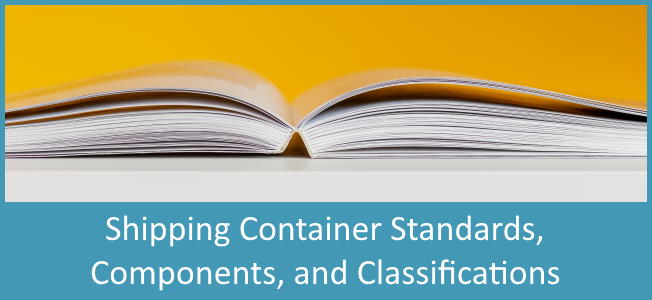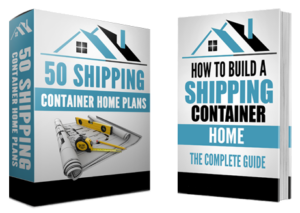The true genius shown by the invention of shipping containers is their standardization. Containers made at different times, by different companies, in different places can still fit together perfectly. And this is no accident.
The shipping container ecosystem is governed by requirements that determine almost everything about them. In a previous article, we covered all the common (and some not-so-common) shipping container dimensions. But below, we’ll focus on how containers are described, classified, and constructed.
Container Standards
The official standards for containers are controlled by the International Organization for Standardization or ISO. The relevant information is actually contained in several different documents, including:
- ISO 830 provides definitions and terminology related to containers
- ISO 6346 covers the container classification codes and markings
- ISO 1161 describes the corner castings used in containers.
- ISO 668 is focused on the dimensions and ratings of containers
- ISO 1496 gives the specifications and testing procedures for containers
Unfortunately, you must purchase a copy of the ISO standards in order to access them. However, your local library may be able to grant electronic access.
Most people will never need to delve deep into the standards anyway. They are written for professionals who build containers or parts that work with them, rather than the individual consumer. Pretty much everything you’ll actually need to know about containers, you can find on our website – for free!
Container Classification
We mentioned above that ISO 6346 covers the classification of containers, and you might be wondering what exactly that means. Even though you may only be familiar with a handful of container types and sizes, there are actually dozens of possible configurations.
Rather than having to use multi-word descriptions every time you need to refer to one, a code system was built to make things more efficient and uniform. Containers are identified by a 4-digit alphanumeric size and type code specified in ISO 6346. The first two digits are what is called the ‘size code’ and the second two digits are the ‘type code’. Here is what those two codes mean:
- First and Second Digit: Length and Width/Height
- Third and Fourth Digits: Features/Characteristics
Let’s try a few examples:
22R0
- First Digit: ‘2’ meaning 20ft long
- Second Digit: ‘2’ meaning 8ft 6in tall and 8ft wide
- Third and Fourth Digits: ‘R0’ meaning Mechanically Refrigerated
MNG1
- First Digit: ‘M’ meaning 48ft long
- Second Digit: ‘N’ meaning 9ft 6in tall and at least 8ft 2.4inches wide
- Third and Fourth Digits: ‘G1’ meaning General Purpose Container with small vents in the upper part of the cargo space
You can look up the meaning of most of these codes with this tool.
Container Companies
There can be slight differences in the measurements of containers from different manufacturers, while still meeting ISO standards. However, it’s usually pretty hard to find the information about specific container manufacturers as they don’t really market to consumers. Instead, you may be able to find the shipping line or company that originally used the container and get relevant information that way.
Here are links to the dimension information from a few of the major shipping container companies:
These are some of the most common company names you’ll see painted on the side of new or used containers.
Container Components and Pieces
Despite their monolithic construction, containers are actually just assemblies of dozens of parts welded together into the steel boxes you’re familiar with. Below we describe the major shipping container components including sizes and potential varieties you might encounter.
Corners
One of the signature parts of a container is its cast metal corners. The solid chunks of steel have elongated holes in them that are what the twist-lock fittings attach too. The corners are what give containers their modularity and allow them to be attached to other things and each other.
Container Corner Castings
The corner fittings themselves are made of cast steel and typically have holes in the three sides that don’t face back towards the container itself.
In general, the holes are roughly 2-3 inches in diameter (though oblong), but they aren’t all shaped alike. There is also a difference in some of the holes depending on if the corner is at the top or bottom of the container.
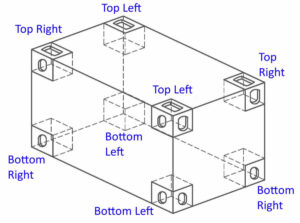
To see very specific measurements of each hole on each corner container, either reference ISO 1161 or find a reseller/manufacturer who sells the fittings and has detailed shop drawings available like Tandemloc or Pacific Marine.
Container Corner Spacing
Part of understanding the corners themselves is understanding how they are spaced. The exterior size of a container is slightly less important than the position of the corner fittings. The corners are the places where containers touch each other, and thus their positioning is crucial.
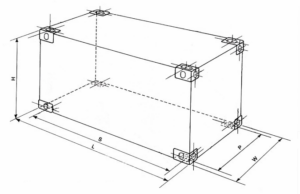
The most important container corner dimension is the distance between the center of the holes both widthwise (labeled ‘P’ above) and lengthwise (labeled ‘S’ above).
For effectively all containers, P is 2259mm (7ft 4.94in). For 40ft containers, S is 11985mm (39ft 3.85in). For 20ft containers, S is 5853mm (19ft 2.43in)
Wider containers liked pallet wide and 48ft/53ft models, normally still have the same P measurement. This is done by having the holes in their corner fittings moved a little bit inward.
The containers we have discussed that are longer than 40 feet (45ft, 48ft, and 53ft containers) actually have an extra eight ‘corner’ fittings that are 40ft apart in addition to the fittings at the actual corners.
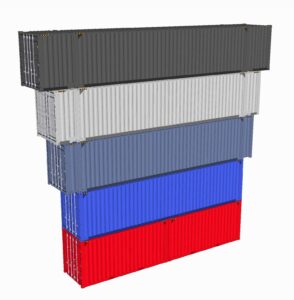
The extra eight ‘corner’ fittings, sometimes called intermediate corners, can be shaped a little differently than normal corners. As mentioned earlier, the longer containers can be a few inches wider, and thus the intermediate corner fittings have to position the holes inboard a bit to correctly interface with regular containers.
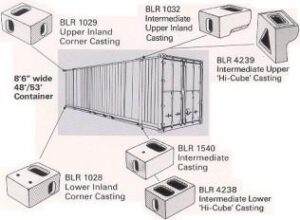
The vertical distance between the centers of the holes in the top and bottom container corner fittings varies based on the height of the container. The distance is usually about 5.6in (142mm) less than the overall height, though it isn’t directly specified by the ISO.
Sheet Metal Skin
Containers are famous for the corrugated sheet metal panels that make up their sides and top. While not all containers have them (for instance, refrigerated containers have smooth exteriors), most do in order to get added strength. And while there can be some variability in the dimensions of the corrugations, most modern containers do use the same corrugation dimensions.
One thing you may not know is that the actual corrugations are different between the long sides, the short side (the front and back including the doors), and the top. Below we’ll show dimensions of all three types of corrugations.
Container Side Corrugation
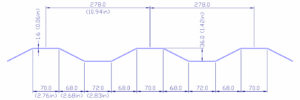
The sides of a container typically have vertical corrugations. The overall thickness of the corrugation is what contributes to the loss in the interior width of a container, which is why this corrugation, in particular, is important to pay attention to.
Container End Corrugation
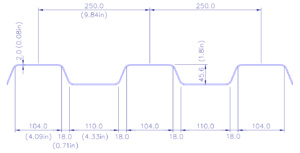
Most containers only have one set of doors, while the other end is a solid wall of corrugated steel. This solid end has a different corrugation that is unique. However, it is oriented vertically, so it may appear similar to the side corrugation from far away.
Container Door Corrugation
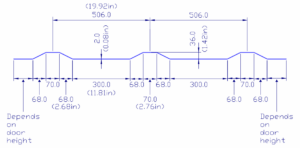
Every container has at least one set of doors, and the double-ended (tunnel) containers have two sets. The doors themselves have corrugations, though the number and orientation of the corrugations vary quite a bit between containers.
Typically there are two to five horizontal corrugations per door, although three is the most common and what we cover above. Usually, the horizontal corrugations are vertically centered on each door.
Container Roof Corrugation
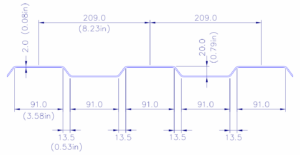
The roof of a shipping container has a unique shape that is a little different than the other pieces of sheet metal. Instead of just being a flat piece of steel that is bent in only one dimension (so that the entire length of the panel has the same cross-section as the back and sides), the roof is shaped in three dimensions.
First, it has a very slight camber or convex bend in it, so the water will flow to the sides of the container. Also, the corrugations don’t go all the way to the edges of the roof, but rather end in a circle a few inches from the edge.
Floor
The floor of a shipping container is typically made of plywood (thin sheets or plys of wood veneer that are glued together, with each ‘ply’ turned 90 degrees from the one below it). As mentioned previously, some containers use bamboo or metal flooring, but this isn’t as common.
The plywood in a container home is usually about 1-1/8 in (28mm) thick and made out of either 19 or 21 plies of high-density tropical hardwoods. Oftentimes, it is a variety of wood called Apitong.
The plywood is screwed into steel C-channel cross members under the floor that span across the width of the container. Container manufacturers don’t have a standard size and spacing of these cross members so we won’t give any dimensional information. However, they are typically spaced less than 2ft apart and are welded to both bottom rails of the container.
The open area under the floor and between the cross members typically has about six inches of vertical free space above ground level, which is where you can run utilities. The spacing of cross members is also affected by the presence of forklift pockets and the gooseneck tunnel.
Conclusion
After reading this article, you should have a better grasp of the systems that control how containers are described, sized, and even built. It’s a fascinating accomplishment to get people across the world working off of the same classification codes, based on the same governing standards, and using components with the same dimensions regardless of manufacturing company details.

